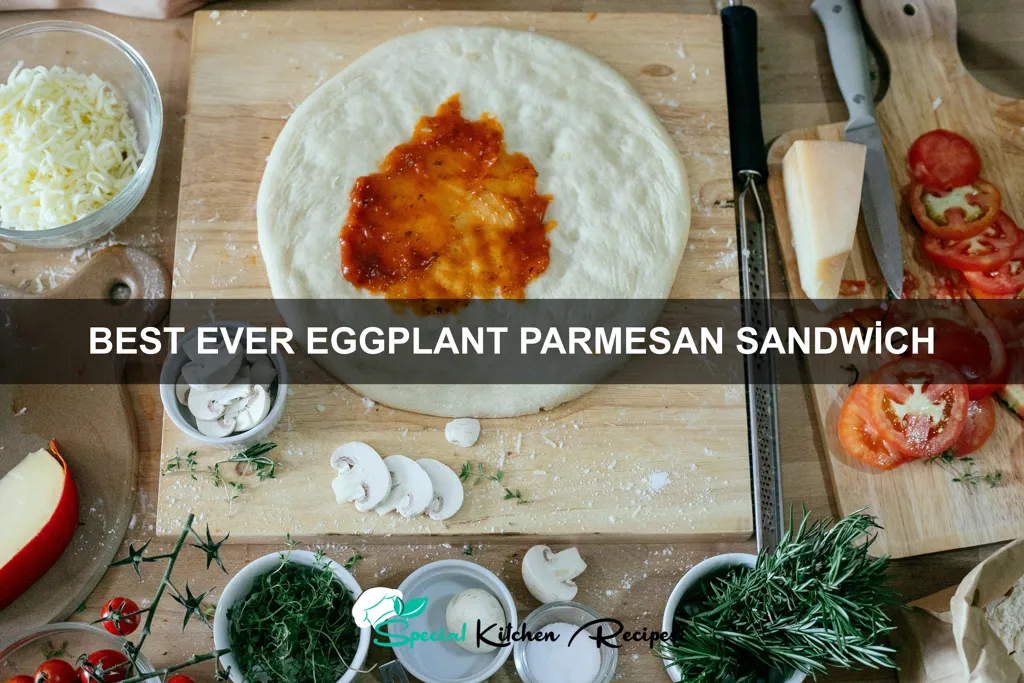The humble eggplant parmesan sandwich: a culinary chameleon that transcends mere sustenance, morphing from simple street food to sophisticated gourmet offering. While pinpointing its precise origin is difficult, its roots lie firmly in the rich tapestry of Italian-American cuisine. The dish’s development likely mirrors the evolution of eggplant parmesan itself, a dish that gained popularity in the United States during the early to mid-20th century, as Italian immigrants brought their culinary traditions across the Atlantic. The sandwich, a more portable and arguably less formal iteration, likely emerged in the bustling urban environments of major US cities, perfect for a quick and satisfying lunch or snack. It’s a testament to the adaptability of classic recipes, proving that even the most beloved dishes can be reimagined for modern convenience.
The cultural significance of the eggplant parmesan sandwich is intertwined with the broader history of Italian-American culture in the United States. Eggplant, a staple in Mediterranean cuisine, became a readily available and affordable ingredient for many Italian-American families, leading to its prominent role in countless dishes. The sandwich, therefore, reflects a history of adaptation and resourcefulness, transforming readily available ingredients into a delicious and satisfying meal. Interestingly, there are no precise statistics on the annual consumption of eggplant parmesan sandwiches, largely because it’s often prepared and enjoyed at home, rather than purchased from commercially tracked establishments. However, its enduring popularity is undeniable, evidenced by the countless recipes and variations found online and in cookbooks.
What truly makes this Best Ever Eggplant Parmesan Sandwich exceptional is its commitment to quality ingredients and a perfect balance of flavors. Forget soggy bread and bland sauce – this recipe prioritizes crispy, perfectly fried eggplant slices, a rich and tangy marinara sauce bursting with fresh herbs, and the creamy indulgence of melted mozzarella cheese, all nestled between toasted, artisanal bread. It aims to elevate the classic street food to a culinary experience, a testament to the power of simple ingredients expertly combined. This recipe isn’t just about replicating a familiar favorite; it’s about celebrating the history and cultural impact of this beloved dish, while simultaneously presenting a modern and refined interpretation that will undoubtedly satisfy even the most discerning palate. Prepare to be amazed.
Ingredients and Measurements
This recipe for the Best Ever Eggplant Parmesan Sandwich relies on fresh, high-quality ingredients to achieve its incredible flavor. Precise measurements are key to ensuring the perfect balance of textures and tastes. Don’t be tempted to substitute ingredients without careful consideration, as this could significantly impact the final product.
For the Eggplant: You’ll need one large globe eggplant (approximately 1 pound). Choose an eggplant that is firm to the touch and free of blemishes. Avoid using overly ripe eggplants, as they can be bitter. You will also need approximately 1 teaspoon of kosher salt. This salt is crucial for drawing out excess moisture from the eggplant, preventing a soggy sandwich. We use kosher salt because it’s less salty per volume than table salt, giving you better control over the seasoning.
For the Breading: We’ll be using a classic Italian breading technique. You will need 1 cup of all-purpose flour, 2 large eggs lightly beaten with 1 tablespoon of water, and 1 ½ cups of Italian seasoned breadcrumbs. Ensure your breadcrumbs are finely ground for optimal adhesion to the eggplant. Panko breadcrumbs can be substituted, but they tend to result in a slightly crispier, less traditional texture.
For the Sauce: A generous amount of high-quality marinara sauce is essential. Use about 1 ½ cups of your favorite marinara sauce. Homemade marinara sauce is strongly recommended for the best flavor, but a high-quality store-bought variety will work in a pinch. Make sure your sauce is well-seasoned with salt, pepper and any preferred herbs.
For the Cheese: We’ll use a blend of cheeses to achieve a rich and flavorful melt. You’ll need ½ cup of shredded mozzarella cheese and ¼ cup of grated Parmesan cheese. Freshly grated Parmesan cheese is preferred for its superior flavor and texture compared to pre-grated varieties. You can substitute provolone or another firm Italian cheese for the mozzarella if desired, but the mozzarella provides the best stretch and melt.
For the Sandwich: Finally, you’ll need 2 large crusty Italian rolls or hero rolls, sliced lengthwise. The bread should be sturdy enough to hold all the ingredients without collapsing. You may also want to lightly toast your rolls before assembling the sandwich for enhanced texture and to prevent sogginess.
Equipment List
Creating the best ever eggplant parmesan sandwich requires the right tools for the job. While you might have many substitutes available, using the correct equipment enhances the overall cooking process and yields superior results. This list details the necessary equipment, including recommendations for optimal performance.
Large Baking Sheet (18×26 inches or larger): This provides ample space for even roasting of the eggplant slices. Smaller trays may lead to overcrowding and uneven cooking, resulting in soggy eggplant. A non-stick baking sheet is highly recommended to prevent sticking and simplify cleanup. If you don’t have a large enough baking sheet, consider using two smaller ones.
Large, Sharp Chef’s Knife (8-10 inches): Precise slicing of the eggplant is crucial. A dull knife will crush the eggplant, resulting in uneven cooking and a less appealing texture. A sharp chef’s knife allows for clean, even slices, ensuring consistent cooking times and a superior final product. Consider using a mandoline slicer for perfectly uniform slices, if you have one.
Large Mixing Bowls (at least two, 3-quart capacity): You’ll need one bowl for breading the eggplant and another for combining the marinara sauce and cheese. Larger bowls offer more space to work with, reducing the risk of spills and making the breading process more efficient.
Whisk: A whisk is essential for thoroughly combining the egg wash and for blending any spices or herbs into the marinara sauce. A balloon whisk is ideal for its efficient whipping action.
Shallow Dishes (three, approximately 9-inch diameter): You’ll need three shallow dishes for the breading station: one for the flour, one for the beaten eggs, and one for the breadcrumbs. These allow for easy, even coating of the eggplant slices.
Large Skillet (12-inch diameter): A large skillet is needed for frying or sautéing the eggplant slices. Cast iron is ideal for even heat distribution, but a non-stick skillet will also work well. Ensure your skillet is large enough to accommodate the eggplant slices without overcrowding.
Spatula or Tongs: You’ll need a spatula or tongs for flipping the eggplant slices during cooking and for assembling the sandwiches. A wide spatula is best for handling the larger eggplant slices.
Oven-safe Baking Dish (9×13 inches or similar): If you choose to bake the assembled sandwiches, you’ll need an oven-safe dish to hold them during baking. A rectangular dish is ideal for even heating.
Measuring Cups and Spoons: Accurate measurements are crucial for achieving the desired flavor balance. Using measuring cups and spoons ensures consistency in your recipe.
Paper Towels: Plenty of paper towels are needed for blotting excess oil from the fried eggplant slices.
Eggplant Preparation (Slicing, Salting, and Drying)
Proper eggplant preparation is crucial for a delicious Eggplant Parmesan sandwich. Neglecting this step can result in a soggy, oily sandwich, far from the crispy, flavorful experience we’re aiming for. We’ll start by selecting firm, glossy eggplants, avoiding any that are bruised or soft.
First, wash the eggplant thoroughly and trim off the stem. Using a sharp knife or mandoline slicer, slice the eggplant into 1/4-inch thick rounds. Consistency in thickness is key for even cooking. Aim for slices that are as uniform as possible to ensure they all cook at the same rate.
Now comes the crucial salting step. This is essential for drawing out excess moisture from the eggplant. Excess moisture is the enemy of a crispy eggplant. Place the eggplant slices in a single layer on a large plate or shallow dish. Generously sprinkle both sides of each slice with kosher salt. About 1 tablespoon of salt per 2 medium-sized eggplants should suffice. Let them sit for at least 30 minutes, and up to an hour. This allows the salt to draw out the bitterness and excess water.
After the salting period, you’ll notice that the eggplant has released quite a bit of liquid. Gently rinse the eggplant slices under cold running water, ensuring all the salt is removed. Pat them thoroughly dry with paper towels. This step is vital; any remaining moisture will hinder the browning process during frying.
Finally, let the eggplant slices air dry for at least 15-20 minutes. You can speed up the drying process by placing them on a wire rack or between layers of paper towels. The drier the eggplant, the crispier the outcome. This extra step guarantees a superior texture and prevents your sandwich from becoming soggy.
Once the eggplant slices are completely dry, you’re ready to proceed with breading and frying. Following these steps meticulously will ensure your Eggplant Parmesan sandwich is the best ever!
Breading the Eggplant (Step-by-step instructions)
Properly breading the eggplant is crucial for achieving a crispy, flavorful eggplant parmesan sandwich. This process involves three distinct steps: dredging in flour, dipping in egg, and finally, coating in breadcrumbs. We’ll use approximately 1 medium-sized eggplant (about 1 pound) for this recipe. Adjust quantities as needed based on the size of your eggplant and the number of sandwiches you’re making.
Step 1: Prepare the Eggplant Slices: Begin by slicing the eggplant into 1/4-inch thick rounds. Thinner slices will cook faster and result in a crispier texture, but be careful not to make them too thin or they may break easily. If your eggplant is particularly large, you may want to halve it lengthwise before slicing. Once sliced, sprinkle the eggplant rounds generously with salt on both sides. This will help draw out excess moisture, preventing soggy breading and resulting in a crispier final product. Let the eggplant sit for at least 30 minutes, preferably an hour, on a wire rack or paper towel-lined plate to allow the moisture to drain completely.
Step 2: The Flour Dredge: After the eggplant has released its moisture, gently pat each slice dry with paper towels. This is extremely important for achieving a good breading. Place about 1 cup of all-purpose flour in a shallow dish. One by one, dredge each eggplant slice in the flour, ensuring it’s fully coated on both sides. Gently shake off any excess flour to avoid a thick, pasty coating.
Step 3: The Egg Wash: In a separate shallow dish, whisk together 2 large eggs with 2 tablespoons of milk or water. The liquid helps the breading adhere better. Dip each flour-coated eggplant slice into the egg mixture, making sure it’s completely submerged. Let any excess egg drip off before moving to the next step.
Step 4: The Breadcrumb Coating: In a third shallow dish, place about 1 1/2 cups of breadcrumbs. You can use panko breadcrumbs for an extra-crispy texture, or regular breadcrumbs will work fine. For extra flavor, consider adding 1/4 cup of grated Parmesan cheese to your breadcrumbs. Press each egg-dipped eggplant slice into the breadcrumbs, ensuring a thorough coating on both sides. Gently press the breadcrumbs onto the eggplant to help them adhere better. Avoid pressing too hard, as this can compact the breading.
Step 5: Rest and Fry (or Bake): Once all the eggplant slices are breaded, you can either fry them in hot oil (350°F) for 3-4 minutes per side, or bake them in a preheated oven at 400°F for 20-25 minutes, flipping halfway through. Both methods yield delicious results, though frying will give you a crispier exterior.
Cooking the Eggplant (Pan-frying or Baking)
Before you even think about assembling your incredible Eggplant Parmesan Sandwich, you need perfectly cooked eggplant. We’ll explore two methods: pan-frying and baking. Both yield delicious results, but offer slightly different textures.
Pan-frying produces a crispier exterior and a slightly softer interior. For this method, you’ll need about 1 large or 2 medium eggplants. Slice the eggplant into 1/4-inch thick rounds. Generously salt both sides of the eggplant slices. This crucial step draws out excess moisture, preventing soggy eggplant. Let them sit in a colander for at least 30 minutes, ideally an hour. After salting, pat the slices dry with paper towels.
Heat about 1/4 cup of olive oil in a large skillet over medium-high heat. Once the oil is shimmering, carefully add the eggplant slices, working in batches to avoid overcrowding the pan. Avoid overcrowding the pan, as this will lower the temperature and result in stewing rather than frying. Fry for 3-4 minutes per side, until golden brown and tender. Remove from the pan and place on a wire rack to drain excess oil.
Baking offers a healthier alternative, resulting in a slightly softer, but still flavorful, eggplant. Preheat your oven to 400°F (200°C). Again, slice the eggplant into 1/4-inch thick rounds and generously salt both sides. Let them sit for at least 30 minutes to an hour, then pat dry. Arrange the eggplant slices in a single layer on a baking sheet lined with parchment paper. Drizzle with 2 tablespoons of olive oil and toss gently to coat. Bake for 20-25 minutes, flipping halfway through, until tender and lightly browned.
Regardless of your chosen method, ensure the eggplant is cooked through and slightly tender. Undercooked eggplant will be bitter and unpleasant in your sandwich. Overcooked eggplant will be mushy. Aim for that perfect balance of tender and slightly firm. Once cooked, allow the eggplant to cool slightly before proceeding with the breading and assembly of your sandwich.
Pro Tip: For extra flavor, consider adding a sprinkle of garlic powder or Italian seasoning to the eggplant before cooking, whether pan-frying or baking.
Making the Marinara Sauce
The foundation of a truly exceptional Eggplant Parmesan sandwich lies in a rich and flavorful marinara sauce. This recipe focuses on building layers of flavor, resulting in a sauce far superior to store-bought options. We’ll be using high-quality ingredients and a slow simmering technique to achieve maximum depth.
Begin by gathering your ingredients: 28 ounces (about 790g) of crushed San Marzano tomatoes (San Marzanos are crucial for their sweetness and low acidity), 1/2 cup (120ml) extra virgin olive oil, 4 cloves garlic, minced, 1 teaspoon dried oregano, 1/2 teaspoon dried basil, 1/4 teaspoon red pepper flakes (optional, for a touch of heat), 1 teaspoon salt, and 1/2 teaspoon black pepper. You will also need a large, heavy-bottomed pot.
Heat the olive oil in your pot over medium heat. Once shimmering, add the minced garlic and cook for about 1 minute, or until fragrant. Be careful not to burn the garlic, as this will impart a bitter taste. Stir frequently to prevent browning.
Add the crushed tomatoes, oregano, basil, red pepper flakes (if using), salt, and pepper to the pot. Stir well to combine all the ingredients. Bring the mixture to a gentle simmer, then reduce the heat to low, partially cover the pot, and let it simmer for at least 30 minutes, or up to 1 hour. The longer it simmers, the richer and more flavorful the sauce will become. Stir occasionally to prevent sticking.
During the simmering process, taste the sauce and adjust the seasoning as needed. You may want to add more salt, pepper, or herbs to your liking. Consider adding a pinch of sugar to balance the acidity of the tomatoes if necessary. Once the sauce has reached your desired consistency and flavor, remove it from the heat and set aside. Allow it to cool slightly before using it in your Eggplant Parmesan sandwich.
For an even more intense flavor, consider adding a tablespoon of tomato paste along with the garlic. This will add a deeper, umami note to the sauce. Finally, remember that homemade marinara sauce often tastes even better the next day, so making it ahead of time is highly recommended.
Recommendations for the Best Ever Eggplant Parmesan Sandwich
For the ultimate enjoyment of your Best Ever Eggplant Parmesan Sandwich, we highly recommend serving it immediately after preparation. The warm, melty cheese and crispy eggplant are best appreciated fresh. Avoid microwaving, as this will make the bread soggy and the eggplant rubbery. Instead, gently reheat in a low oven (around 300°F) for a few minutes if necessary.
To elevate your dining experience, consider pairing your sandwich with a crisp side salad. A simple green salad with a light vinaigrette or a Caprese salad with fresh mozzarella and basil would complement the rich flavors of the sandwich perfectly. Alternatively, a side of roasted vegetables, such as zucchini or bell peppers, would add a nice textural contrast. For a heartier meal, serve it with a side of creamy tomato soup or a small bowl of pasta salad.
Leftovers should be stored in an airtight container in the refrigerator for up to 2 days. To prevent the bread from becoming soggy, it’s best to store the sandwich components separately and assemble just before serving. Reheating leftover sandwiches is not recommended, as the texture may suffer significantly. Consider using leftover eggplant parmesan filling in other dishes, such as pasta bake or pizza topping.
Nutritional Information (per serving, approximate): Calories: 600-700 (depending on ingredients and portion size), Fat: 30-40g, Saturated Fat: 10-15g, Cholesterol: 80-100mg, Sodium: 800-1000mg, Carbohydrates: 60-70g, Fiber: 5-7g, Sugar: 5-10g, Protein: 20-25g. Please note: These are estimates and may vary based on specific ingredients used and portion sizes. For accurate nutritional information, use a nutrition calculator with your specific recipe ingredients.





